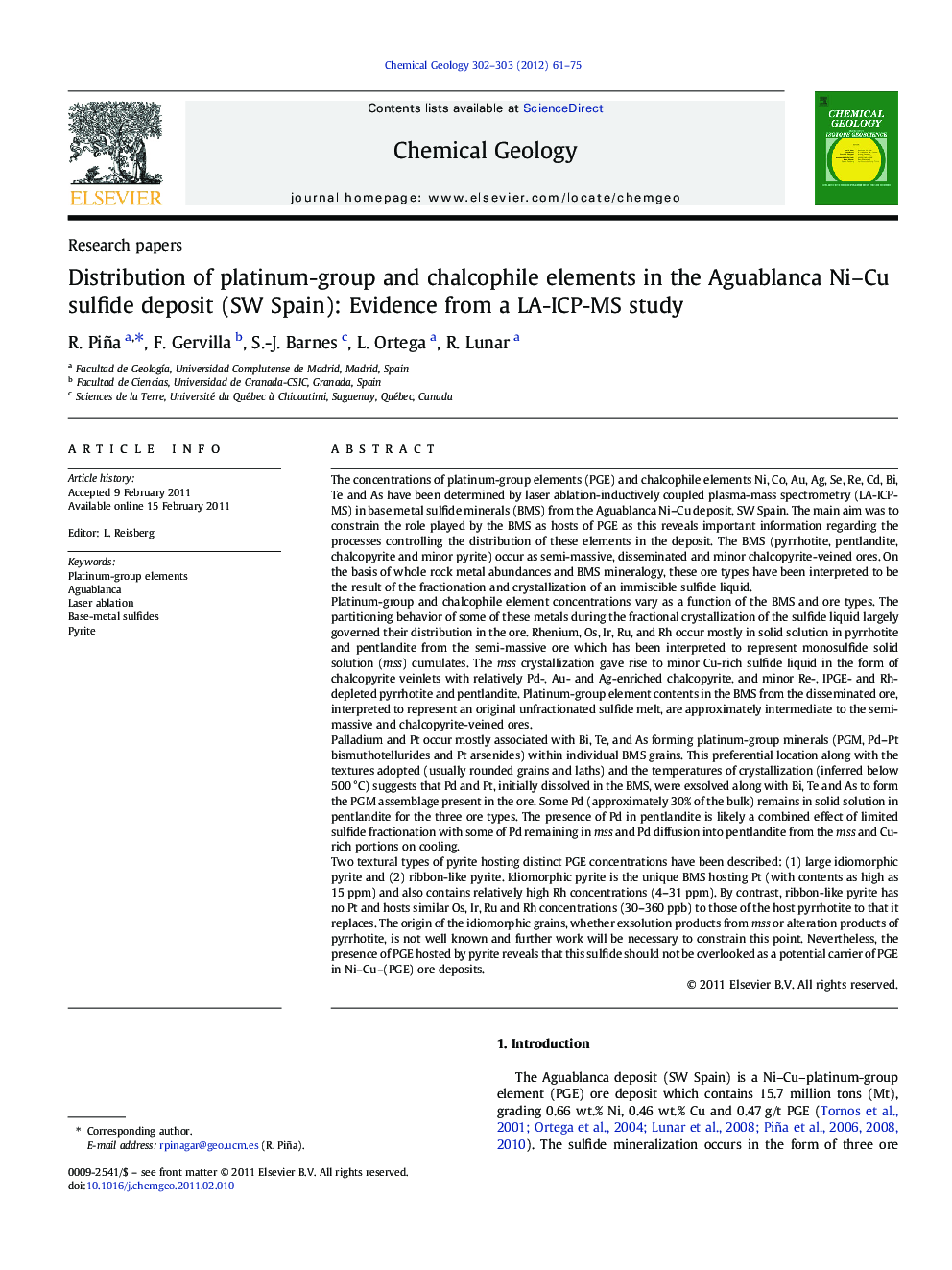| کد مقاله | کد نشریه | سال انتشار | مقاله انگلیسی | نسخه تمام متن |
|---|---|---|---|---|
| 4699432 | 1637649 | 2012 | 15 صفحه PDF | دانلود رایگان |

The concentrations of platinum-group elements (PGE) and chalcophile elements Ni, Co, Au, Ag, Se, Re, Cd, Bi, Te and As have been determined by laser ablation-inductively coupled plasma-mass spectrometry (LA-ICP-MS) in base metal sulfide minerals (BMS) from the Aguablanca Ni–Cu deposit, SW Spain. The main aim was to constrain the role played by the BMS as hosts of PGE as this reveals important information regarding the processes controlling the distribution of these elements in the deposit. The BMS (pyrrhotite, pentlandite, chalcopyrite and minor pyrite) occur as semi-massive, disseminated and minor chalcopyrite-veined ores. On the basis of whole rock metal abundances and BMS mineralogy, these ore types have been interpreted to be the result of the fractionation and crystallization of an immiscible sulfide liquid.Platinum-group and chalcophile element concentrations vary as a function of the BMS and ore types. The partitioning behavior of some of these metals during the fractional crystallization of the sulfide liquid largely governed their distribution in the ore. Rhenium, Os, Ir, Ru, and Rh occur mostly in solid solution in pyrrhotite and pentlandite from the semi-massive ore which has been interpreted to represent monosulfide solid solution (mss) cumulates. The mss crystallization gave rise to minor Cu-rich sulfide liquid in the form of chalcopyrite veinlets with relatively Pd-, Au- and Ag-enriched chalcopyrite, and minor Re-, IPGE- and Rh-depleted pyrrhotite and pentlandite. Platinum-group element contents in the BMS from the disseminated ore, interpreted to represent an original unfractionated sulfide melt, are approximately intermediate to the semi-massive and chalcopyrite-veined ores.Palladium and Pt occur mostly associated with Bi, Te, and As forming platinum-group minerals (PGM, Pd–Pt bismuthotellurides and Pt arsenides) within individual BMS grains. This preferential location along with the textures adopted (usually rounded grains and laths) and the temperatures of crystallization (inferred below 500 °C) suggests that Pd and Pt, initially dissolved in the BMS, were exsolved along with Bi, Te and As to form the PGM assemblage present in the ore. Some Pd (approximately 30% of the bulk) remains in solid solution in pentlandite for the three ore types. The presence of Pd in pentlandite is likely a combined effect of limited sulfide fractionation with some of Pd remaining in mss and Pd diffusion into pentlandite from the mss and Cu-rich portions on cooling.Two textural types of pyrite hosting distinct PGE concentrations have been described: (1) large idiomorphic pyrite and (2) ribbon-like pyrite. Idiomorphic pyrite is the unique BMS hosting Pt (with contents as high as 15 ppm) and also contains relatively high Rh concentrations (4–31 ppm). By contrast, ribbon-like pyrite has no Pt and hosts similar Os, Ir, Ru and Rh concentrations (30–360 ppb) to those of the host pyrrhotite to that it replaces. The origin of the idiomorphic grains, whether exsolution products from mss or alteration products of pyrrhotite, is not well known and further work will be necessary to constrain this point. Nevertheless, the presence of PGE hosted by pyrite reveals that this sulfide should not be overlooked as a potential carrier of PGE in Ni–Cu–(PGE) ore deposits.
Research Highlights
► PGE were determined by LA-ICP-MS in sulfides from the Aguablanca Ni-Cu deposit.
► Os, Ir, Ru and Rh are hosted mostly in sulfides; Pd in pentlandite-PGM; and Pt as PGM.
► Partition coefficients of PGE during sulfide fractionation control their distribution.
Journal: Chemical Geology - Volumes 302–303, 2 April 2012, Pages 61–75